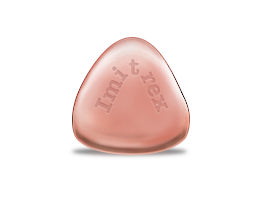
Imitrex, also known by its generic name sumatriptan, is a potent medication prescribed primarily for the treatment of migraines. It is particularly effective in reducing symptoms associated with migraines such as headache pain, nausea, and sensitivity to light and sound. The mechanism of action of Imitrex revolves around its ability to narrow the blood vessels around the brain. This is crucial because during a migraine attack, these blood vessels tend to dilate or expand, which contributes to the characteristic throbbing pain. By narrowing these vessels, Imitrex helps alleviate the pain associated with migraines.


| Package | Per pill | Total price | Save | Order |
|---|---|---|---|---|
| 100mg × 30 Pills | $6.39 | $191.58 + Bonus - 4 Pills | - | Add to cart |
| 100mg × 60 Pills | $6.04 | $362.11 + Bonus - 4 Pills Free Trackable Delivery | $21.00 | Add to cart |
| 100mg × 120 Pills | $5.86 | $703.16 + Bonus - 7 Pills Free Trackable Delivery | $63.60 | Add to cart |
| Package | Per pill | Total price | Save | Order |
|---|---|---|---|---|
| 50mg × 10 Pills | $8.66 | $86.64 + Bonus - 4 Pills | - | Add to cart |
| 50mg × 20 Pills | $6.77 | $135.47 + Bonus - 4 Pills | $37.80 | Add to cart |
| 50mg × 30 Pills | $6.14 | $184.31 + Bonus - 4 Pills | $75.60 | Add to cart |
| 50mg × 60 Pills | $5.51 | $330.81 + Bonus - 4 Pills Free Trackable Delivery | $189.00 | Add to cart |
| 50mg × 90 Pills | $5.30 | $477.31 + Bonus - 7 Pills Free Trackable Delivery | $302.40 | Add to cart |
| 50mg × 120 Pills | $5.20 | $623.81 + Bonus - 7 Pills Free Trackable Delivery | $415.20 | Add to cart |
| Package | Per pill | Total price | Save | Order |
|---|---|---|---|---|
| 25mg × 10 Pills | $6.98 | $69.83 + Bonus - 4 Pills | - | Add to cart |
| 25mg × 20 Pills | $5.46 | $109.18 + Bonus - 4 Pills | $30.40 | Add to cart |
| 25mg × 60 Pills | $4.44 | $266.60 + Bonus - 4 Pills Free Trackable Delivery | $152.40 | Add to cart |
| 25mg × 90 Pills | $4.27 | $384.67 + Bonus - 7 Pills Free Trackable Delivery | $243.90 | Add to cart |
| 25mg × 120 Pills | $4.19 | $502.74 + Bonus - 7 Pills Free Trackable Delivery | $334.80 | Add to cart |
Cluster Headaches: An Overview.
Cluster headaches, a rare form of headache disorder, are known for their distinctive pattern of occurrence and the extreme pain they inflict. They are much less common than other types of headaches, such as tension or migraine headaches. Despite their rarity, their debilitating effects make them a significant neurological condition.
The pain associated with cluster headaches is often described as severe, piercing, or burning. It's characterized by an excruciating pain that tends to concentrate around one eye but can radiate to other areas of the face, neck, or head. The pain intensity can be so extreme that cluster headaches are sometimes referred to as 'suicide headaches'.
One of the defining features of cluster headaches is their recurrence in a consistent pattern. They occur in cyclical clusters or groups, hence the name. Each cluster cycle can last weeks to months, followed by a remission period that can stretch from months to years. This pattern of occurrence is a unique characteristic that differentiates cluster headaches from other headache disorders.
Each cluster headache attack typically lasts between 1 to 3 hours, although it can range from 15 minutes to 3 hours. The pain starts abruptly, reaches its peak within 10 to 15 minutes, and subsides gradually, leaving the person exhausted.
The frequency of cluster headache attacks can vary widely. Some people may experience an attack every other day, while others may be unfortunate enough to have multiple attacks within the same day. These attacks often occur at the same time each day, with a particular predilection for nighttime hours.
Cluster headaches pose a significant challenge due to the intensity and regularity of the pain. While there is currently no cure for cluster headaches, treatments aim to reduce the severity of pain, shorten the headache period, and prevent recurrences. These treatments include medications, nerve blocks, and in severe cases, surgical interventions.
In conclusion, cluster headaches are a rare but severely painful neurological condition that requires timely and effective management. Their unique recurrence pattern and intense symptoms make them distinct from other headache disorders. Despite their debilitating nature, various treatment options are available to help manage the symptoms and improve the quality of life for the affected individuals.
Causes.
Cluster headaches, known for their extreme pain and specific patterns, affect more men than women and typically occur during the 20s through middle age. The exact cause of cluster headaches remains a mystery to doctors, but they are believed to be connected to the sudden release of histamine or serotonin around the trigeminal nerve in the face. In addition, a problem in a small region at the base of the brain called the hypothalamus may play a role in their development.
Histamine and Serotonin Release.
Histamine and serotonin are chemicals produced within the body, and each has its unique function. Histamine is released during an allergic response, while serotonin is made by nerve cells. In the case of cluster headaches, doctors believe that a sudden surge of either histamine or serotonin in the vicinity of the trigeminal nerve can trigger the intense pain and discomfort associated with these headaches.
The Trigeminal Nerve.
The trigeminal nerve is an essential nerve located in the face. It is responsible for carrying sensory information, such as pain, touch, and temperature, from the face to the brain. When the trigeminal nerve is affected by the release of histamine or serotonin, it can result in the throbbing and excruciating pain that is characteristic of cluster headaches.
The Hypothalamus.
Recent research has suggested that the hypothalamus, a tiny region situated at the base of the brain, may be involved in the development of cluster headaches. The hypothalamus is responsible for regulating various bodily functions, including sleep, hunger, and thirst. It also plays a role in the release of hormones and the regulation of the autonomic nervous system. An issue within the hypothalamus could potentially contribute to the onset of cluster headaches.
Genetic Factors.
Cluster headaches tend to run in families, suggesting that there may be a genetic component to their development. While the exact genes involved in these headaches have not been identified, scientists are working to uncover the genetic links to better understand the causes and, ultimately, develop more effective treatments for this debilitating condition.
In conclusion, cluster headaches are a complex and poorly understood condition. The sudden release of histamine or serotonin around the trigeminal nerve, possible involvement of the hypothalamus, and genetic factors are all believed to play a role in their development. With ongoing research, doctors hope to unlock the mysteries behind cluster headaches and find better ways to alleviate the suffering of those affected.
Symptoms.
Cluster headaches are a series of recurring, severe headaches that are known for their distinctive pattern and intensity. They are considered one of the most painful types of headaches and are often misunderstood. In this article, we will explore the symptoms of cluster headaches and their unique pattern of occurrence.
A cluster headache typically begins abruptly, with a severe, sudden pain that is often described as piercing, burning, or explosive. The pain is usually located on one side of the head, often around or behind the eye, and can radiate to the forehead, temple, neck, or shoulder. Unlike migraines, cluster headaches do not have a prodrome or aura phase. Instead, they strike suddenly and reach their peak intensity within minutes.
Cluster headaches have a unique pattern of occurrence. They often start 2 to 3 hours after falling asleep, earning them the nickname 'alarm clock headaches.' However, they can also occur while awake. The headaches tend to happen daily, at the same time of day, which can make it a particularly debilitating condition.
The duration of a cluster headache episode can vary greatly. In some cases, attacks can occur in clusters, lasting for weeks or even months before subsiding. This is known as episodic cluster headaches. The remission period between clusters can last anywhere from months to years.
In contrast, chronic cluster headaches are more persistent. They can occur for a year or more without stopping. Unlike episodic cluster headaches, there are no lengthy pain-free periods. The headaches may subside for a few weeks, only to return again.
part from the severe pain, cluster headaches are also associated with other symptoms. These can include swelling, redness, or drooping of the eyelid on the affected side, tearing or redness of the eye, nasal congestion or runny nose, and facial sweating. Some people may also experience restlessness or agitation during an attack.
Understanding the symptoms and patterns of cluster headaches is crucial for proper diagnosis and treatment. If you experience recurring, severe headaches that fit the description of cluster headaches, it is important to consult a healthcare provider. They can help develop a treatment plan to manage your symptoms and reduce the frequency of attacks.
Treatment. Sumatriptan (Imitrex) for Effective Cluster Headache Relief.
Cluster headaches are a debilitating neurological condition characterized by severe headaches that occur in clusters or cycles. The pain associated with cluster headaches is intense and can be debilitating, often affecting one side of the head. To manage the symptoms of cluster headaches, healthcare providers may recommend a medication called sumatriptan, known by its brand name, Imitrex.
Sumatriptan is a selective serotonin receptor agonist that belongs to a class of drugs called triptans. These medications work by narrowing blood vessels in the brain, thereby halting the pain signaling associated with cluster headaches. In addition, triptans are known for their ability to reduce inflammation, another primary contributing factor to cluster headache symptoms.






